初二英语下册语法精华
- 格式:doc
- 大小:61.00 KB
- 文档页数:20
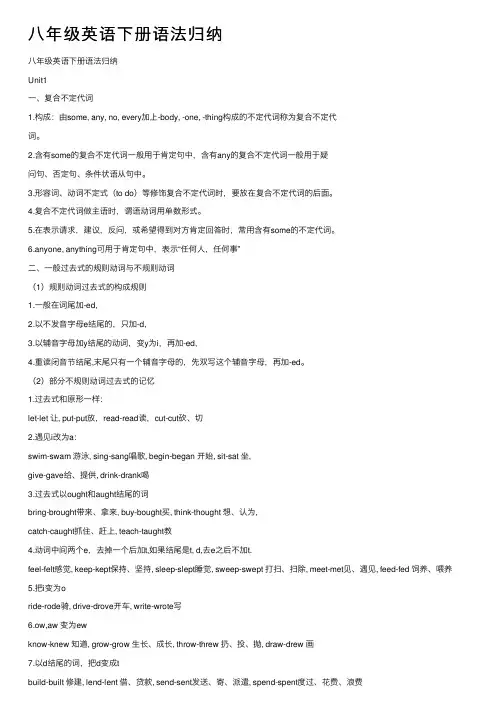
⼋年级英语下册语法归纳⼋年级英语下册语法归纳Unit1⼀、复合不定代词1.构成:由some, any, no, every加上-body, -one, -thing构成的不定代词称为复合不定代词。
2.含有some的复合不定代词⼀般⽤于肯定句中,含有any的复合不定代词⼀般⽤于疑问句、否定句、条件状语从句中。
3.形容词、动词不定式(to do)等修饰复合不定代词时,要放在复合不定代词的后⾯。
4.复合不定代词做主语时,谓语动词⽤单数形式。
5.在表⽰请求,建议,反问,或希望得到对⽅肯定回答时,常⽤含有some的不定代词。
6.anyone, anything可⽤于肯定句中,表⽰“任何⼈,任何事”⼆、⼀般过去式的规则动词与不规则动词(1)规则动词过去式的构成规则1.⼀般在词尾加-ed,2.以不发⾳字母e结尾的,只加-d,3.以辅⾳字母加y结尾的动词,变y为i,再加-ed,4.重读闭⾳节结尾,末尾只有⼀个辅⾳字母的,先双写这个辅⾳字母,再加-ed。
(2)部分不规则动词过去式的记忆1.过去式和原形⼀样:let-let 让, put-put放,read-read读,cut-cut砍、切2.遇见i改为a:swim-swam 游泳, sing-sang唱歌, begin-began 开始, sit-sat 坐,give-gave给、提供, drink-drank喝3.过去式以ought和aught结尾的词bring-brought带来、拿来, buy-bought买, think-thought 想、认为,catch-caught抓住、赶上, teach-taught教4.动词中间两个e,去掉⼀个后加t,如果结尾是t, d,去e之后不加t.feel-felt感觉, keep-kept保持、坚持, sleep-slept睡觉, sweep-swept 打扫、扫除, meet-met见、遇见, feed-fed 饲养、喂养5.把i变为oride-rode骑, drive-drove开车, write-wrote写6.ow,aw 变为ewknow-knew 知道, grow-grow ⽣长、成长, throw-threw 扔、投、抛, draw-drew 画7.以d结尾的词,把d变成tbuild-built 修建, lend-lent 借、贷款, send-sent发送、寄、派遣, spend-spent度过、花费、浪费Unit2频度副词1.表⽰次数、频率的副词称为频度副词。
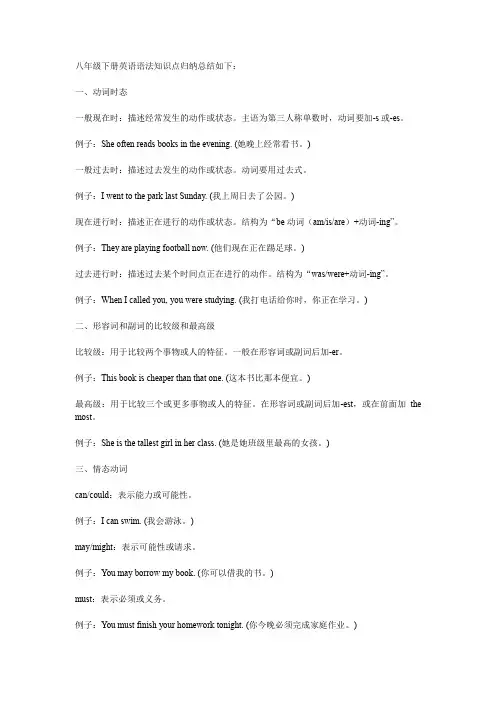
八年级下册英语语法知识点归纳总结如下:一、动词时态一般现在时:描述经常发生的动作或状态。
主语为第三人称单数时,动词要加-s或-es。
例子:She often reads books in the evening. (她晚上经常看书。
)一般过去时:描述过去发生的动作或状态。
动词要用过去式。
例子:I went to the park last Sunday. (我上周日去了公园。
)现在进行时:描述正在进行的动作或状态。
结构为“be动词(am/is/are)+动词-ing”。
例子:They are playing football now. (他们现在正在踢足球。
)过去进行时:描述过去某个时间点正在进行的动作。
结构为“was/were+动词-ing”。
例子:When I called you, you were studying. (我打电话给你时,你正在学习。
)二、形容词和副词的比较级和最高级比较级:用于比较两个事物或人的特征。
一般在形容词或副词后加-er。
例子:This book is cheaper than that one. (这本书比那本便宜。
)最高级:用于比较三个或更多事物或人的特征。
在形容词或副词后加-est,或在前面加the most。
例子:She is the tallest girl in her class. (她是她班级里最高的女孩。
)三、情态动词can/could:表示能力或可能性。
例子:I can swim. (我会游泳。
)may/might:表示可能性或请求。
例子:You may borrow my book. (你可以借我的书。
)must:表示必须或义务。
例子:You must finish your homework tonight. (你今晚必须完成家庭作业。
)四、被动语态被动语态用于描述事物的状态或描述被动发生的动作。
结构为“be动词(am/is/are/was/were)+动词的过去分词”。
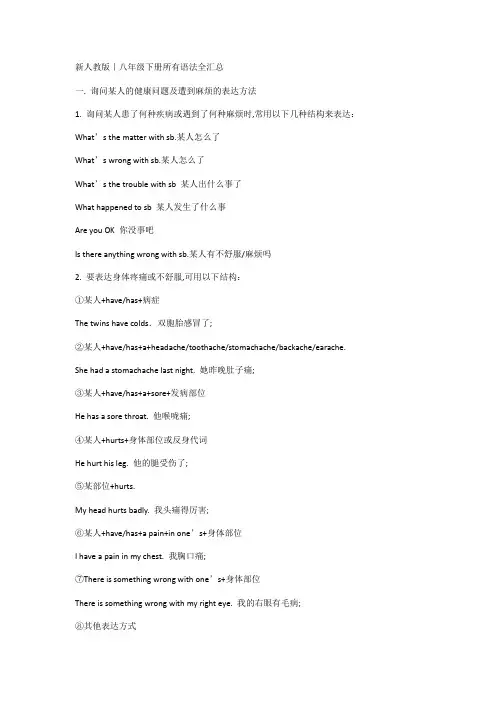
新人教版|八年级下册所有语法全汇总一. 询问某人的健康问题及遭到麻烦的表达方法1. 询问某人患了何种疾病或遇到了何种麻烦时,常用以下几种结构来表达:What’s the matter with sb.某人怎么了What’s wrong with sb.某人怎么了What’s the trouble with sb 某人出什么事了What happened to sb 某人发生了什么事Are you OK 你没事吧Is there anything wrong with sb.某人有不舒服/麻烦吗2. 要表达身体疼痛或不舒服,可用以下结构:①某人+have/has+病症The twins have colds.双胞胎感冒了;②某人+have/has+a+headache/toothache/stomachache/backache/earache. She had a stomachache last night. 她昨晚肚子痛;③某人+have/has+a+sore+发病部位He has a sore throat. 他喉咙痛;④某人+hurts+身体部位或反身代词He hurt his leg. 他的腿受伤了;⑤某部位+hurts.My head hurts badly. 我头痛得厉害;⑥某人+have/has+a pain+in one’s+身体部位I have a pain in my chest. 我胸口痛;⑦There is something wrong with one’s+身体部位There is something wrong with my right eye. 我的右眼有毛病;⑧其他表达方式She has a heart trouble. 她有心脏病;He got hit on the head. 他头部受到了撞击;She cut her finger. 她割破手指了;二. 情态动词should的用法1. should为情态动词,意为“应该;应当”,否定式为shouldn’t,其后接动词原形,无人称和数的变化;常用来表示征询意见、建议、劝告、要求或义务等;You should drink more water. 你应该多喝水;He should put his head back. 他应该把头后仰;We should try our best to help him. 我们应当尽力去帮助他; You shouldn‘t watch TV. 你不应该看电视;2. should用于主语为第一人称的疑问句,表示征询意见;Should I put some medicine on it 我应当给它敷上药吗Should we tell her about it 我们应该告诉她这件事吗3. 在英语中,表示建议的说法有很多,而且都是中考考查的重点;主要结构有:①Would you like to do sth你想要/愿意做某事吗Would you like to play basketball with me 你想要和我一起打篮球吗②Shall I/we do sth 我/我们做某事好吗Shall we go to the zoo tomorrow 明天我们去动物园,好吗③Why not do sth 为什么不......呢Why not join us为什么不加入到我们当中来呢④How/What about doing sth 做某事怎么样How about going swimming 去游泳怎么样⑤Let’s do sth. 让我们做......吧;Let’s go home. 咱们回家吧;⑥You’d better not do sth 你最好不要做某事;You’d better not go there alone. 你最好不要一个人去那儿;三. 反身代词英语中共有八个反身代词,在使用时应注意和它所指的相应的对象在人称、性别和数上保持一致;第一人称第二人称第三人称单数myself yourself himself/herself/itself复数ourselves yourselves themselves反身代词的用法1. 可用作宾语,指的是宾语和主语表示同一个或同一些人或事物;如:Maria bought herself a scarf.We must look after ourselves very well.2. 可用作表语,指的是表语和主语表示同一个或同一些人或事物;如:She isn’t quite herself today.3. 可用作主语或宾语的同位语,常用来加强语气;如:She herself will fly to London tomorrow.I met the writer himself last week.4. 用在某些固定短语当中;如:look after oneself / take care of oneself 照顾自己teach oneself sth./learn sth. by oneself 自学enjoy oneself 玩得高兴,过得愉快help oneself to sth 请自用……随便吃/喝些……hurt oneself 弄伤自己say to oneself 自言自语leave sb. by oneself 把某人单独留下注意反身代词不能单独做主语,但可以做主语的同位语,起强调作用;如:我自己能完成作业;误Myself can finish my homework.正I myself can finish my homework. / I can finish my homework myself.四. 一般将来时一般将来时表示将来某个时间要发生的动作或状态,或将来经常发生的动作或状态; 一般将来时的基本结构1. will+动词原形否定式:will not=won't一般疑问式:will/shall+主语+动词原形+其他特殊疑问式:特殊疑问词+一般疑问式—Will he help you with your English tonight今天晚上他会帮助你学习英语吗—Yes, he will./No, he won't.是的,他会;/不,他不会;—When will you arrive for America你什么时候去美国—Tomorrow.明天;2. am/is/are going to +动词原形否定式:am/is/are not going to +动词原形一般疑问式:am/is/are +主语+ going to + 动词原形+其他特殊疑问式:特殊疑问词+一般疑问式Look at the dark clouds. There is going to be a storm.看那乌云,快要下雨了;Is he going to collect any data for us他会帮我们收集数据吗What are you going to do tomorrow明天你打算作什么3. will+动词原形与am/is/are going to +动词原形的用法区别will+动词原形与am/is/are going to +动词原形的用法虽然都表示将来发生动作或情况,一般情况下能互换;但它们的用法是有区别的;will主要用于在以下三个方面:1表示主观意愿的将来;They will go to visit the factory tomorrow.明天他们将去厂参观工厂;2表示不以人的意志为转移的客观的将来;He will be thirty years old this time next year.明年这个时候他就将三十岁;3表示临时决定,通常用于对话中;—Mary has been ill for a week.玛丽病了一周了;—Oh, I didn't know. I will go and see her.噢,我不知道;我去看看她;be going to主要用于以下两个方面:1表示事先经过考虑、安排好打算、计划要做某事;Dad and I are going to watch an opera this afternoon.今天下午我和爸爸打算去看歌剧;2表示根据目前某种迹象判断,某事非常有可能发生,表示推测;Look There come the dark clouds. It is going to rain.瞧乌云密集;天要下雨了;五. 动词不定式to do的用法1. 作主语为避免句子的头重脚轻,常用it作为形式主语,而真正的主语动词不定式后置;常用句型:It +be+adj./n.+for/of sb. to do sth./It takes sb. some time to do sth.2. 作宾语动词want, decide, hope, ask, agree, choose, learn, plan, need, teach, prepare常接动词不定式作宾语;3. 作后置定语常用于“have/has+sth.+to do”或“Its time to do sth.”等结构中;4. 作宾语补足语tell, ask, want, invite, teach, like, call等可接带to的动词不定式作宾语补足语,构成tell/ask/want /call/invite sb. to do sth.结构;注意动词不定式作使役动词和感官动词的宾语补足语时应省去to:“一感feel,二听listen to, hear,三让let, make, have,四看look at, see, watch, notice,半帮助help”;5. 动词不定式作状语主要用来修饰动词,表示目的,结果或原因;为了强调目的,有时可以把动词不定式放在句首,或在不定式前加in order to 或so as to “为了,目的是”;六. Could you please...句型1. 请求别人时通常用此句型,也可以说Can you...please情态动词could或can在这里均表示请求,在意思上无区别,但是用could在于其显得更委婉、客气、诚恳;在日常生活中常使用could you/I...若在句末加上please,则显得更礼貌;Could you help me find my book, please你能帮我找到我的书吗2. 对could you/I...的问句作出肯定回答,常用“sure/certainly/of course”等;如果作否定回答,常用“sorry或oh, please don’t”; 一般不用no开头,用no显得语气生硬、不礼貌;3. 表示请求的其他句式Would you like to do...Would you mind doing...Let’s do....Please do...祈使句前加please七. 过去进行时1. 基本概念:过去进行时表示在过去某一时刻或一段时间内正在进行的动作;这一特定的过去时间除有上下文暗示以外, 一般用时间状语来表示;常用的时间状语this morning, the whole morning, all day yesterday, from nine to ten last evening, when, while等;We were watching TV from seven to nine last night.昨天晚上七点到九点的时候我们在看电视;It was raining when they left the station.他们离开车站的时候天正在下雨;2. 基本结构was / were not + 动词-ing3. 一般过去时与过去进行时用法的比较一般过去时表示在过去某个时间发生过的动作或存在的状态, 而过去进行时则表示在过去某一时刻或某一段时间正在进行的动作;David wrote a letter to his friend last night. 大卫昨晚给他的朋友写了封信;信写完了;David was writing a letter to his friend last night. 大卫昨晚一直在给他的朋友写信;信不一定写完;八. 状语从句1. unless引导条件状语从句unless = if...not... 除非,若不They will go tomorrow unless it rains.= They will go tomorrow if it doesn’t rains.2. as soon as引导时间状语从句,意为“一...就...”;He will come and see you as soon as he can.3. so...that...引导结果状语从句句型1:主语+谓语+so+形容词/副词+that从句The wind was so strong that we could hardly move forward. 句型2:so +形容词+ a/an + 单数名词+ that从句It was so hot a day that they all went swimming.句型3. so + many/ few + 复数名词+ that从句He has so few friends that he often feels lonely.句型4:so +much/ little + 不可数名词+ that 从句I had so little money that I couldn’t buy a pen.九. 形容词/副词的比较等级形容词和副词有三个比较等级,即原级也就是原形、比较级表示“较……”或“更……”的意思,用于两者之间比较和最高级表示“最……”的意思,用于三者或三者以上的比较;1. 形容词/副词的比较级和最高级的规则变化1单音节词和少数以-er,-ow结尾的双音节单词,比较级在后面加-er,最高级在后面加-est;①单音节单词small→smaller→smallestshort→shorter→shortesttall→taller→tallestgreat→greater→greatest②少数以-er,-ow结尾的双音节单词clever→cleverer→cleverestnarrow→narrower→narrowest2以不发音e结尾的单音节单词,比较级在原形后加-r,最高级在原级后加-st;large→larger→largestnice→nicer→nicestable→abler→ablest3以一个辅音字母结尾的闭音节即:辅音+元音+辅音单词中,先双写末尾的辅音字母,比较级加-er,最高级加-est;big→bigger→biggesthot→hotter→hottestfat→fatter→fattest4以“辅音字母+y”结尾的双音节词, 把y改为i,比较级加-er,最高级加-est; easy→easier→easiestheavy→heavier→heaviestbusy→busier→busiesthappy→happier→happiest5其他双音节词和多音节词,比较级在前面加more,最高级在前面加most; beautiful→more beautiful→most beautifuldifferent→more different→most differenteasily→more easily→most easily2. 形容词/副词的比较级和最高级的不规则变化good→better→bestwell→better→bestbad→worse→worstill→worse→worstold→older/elder→oldest/eldestmany/much→more→mostlittle→less→leastfar →further/farther→furthest/farthest3. 原级常用句型1A is as+原级+ as+ B 表示A与B一样...eg. He is as tall as me.2A is not as/so +原级+ as B 表示A不如B...eg. He is not as tall as me.3只能修饰原级的词,very,quite,so,too,so,enough,pretty等;eg. He is too tired to walk on.他太累了以至于不能再继续走了;4. 比较级常用句型1当句中有than时则用比较级;eg. He is fatter than me.2“特殊疑问词+be+形容词比较级,A or B ”eg. Which is bigger,the earth or the moon哪一个更大,地球还是月球3“比较级+and+比较级”表示“越来越...”;eg. The flowers are more and more beautiful.花儿越来越漂亮;English is more and more important. 英语越来越重要了;4“the+比较级,the+比较级”表示“越...,越...”;eg. The more careful you are,the fewer mistakes you’ll make.5可以修饰比较级的词:much,a lot,far,a little,a bit,even,still等;eg. Lesson One is much easier than Lesson Two. 第一课比第二课容易得多;5. 最高级常用句型1.“主语+be+the+形容词最高级+单数名词+in/of...”表示“……是……中最……的”;Tom is the tallest in his class/of all the students.汤姆是他们班上/所有学生当中最高的;2.“主语+实意动词+the+副词最高级+in/of...”表示“……是……中最……的”;I jump the farthest in my class.我是我们班跳得最远的;3.“主语+be+one of the+形容词最高级+复数名词+in/of...”表示“……是……中最……之一”; Beijing is one of the largest cities in China.北京是中国最大城市之一;4.“特殊疑问词+be+the+最高级,甲,乙,or丙”用于三者或三者以上的比较;Which country is the largest,China,Brazil or Canada哪个国家最大,中国,巴西还是加拿大5.“特殊疑问词+助动词+主语+the+副词最高级+甲,乙,or丙”用于三者或三者以上的比较; Which season do you like the best,spring,summer or autumn你最喜欢哪一个季节,春天,夏天还是秋天注意:副词最高级用在句中时,其前可以加the,也可以不加;但形容词最高级用在句中时,其前一般都要加the;十. 现在完成时一. 现在完成时基本结构①肯定句:主语+have/has+动词的过去分词②否定句:主语+have/has+not+动词的过去分词③一般疑问句:Have/Has+主语+动词的过去分词④特殊疑问句:特殊疑问词+一般疑问句have/has+主语+过去分词二. 现在完成时用法1. 现在完成时用来表示过去已经完成的动作对现在造成影响或后果;也就是说,动作或状态发生在过去但它的影响现在还存在,强调的是现在;I have already posted the photo.我已经邮寄出了照片;与此种用法连用的时间状语时一些模糊的过去时间状语,如already肯定句, yet否定句/疑问句, just, before, recently,still, lately,never等;2. 现在完成时也可用来表示动作或状态发生在过去某一时刻,持续到现在并且有可能会继续持续下去;He has lived here since 1978.自从1978年以来,他一直住在这儿;动作起始于1978年,一直住到现在,可能还要继续住下去;此种用法常与for+时间段,since+时间点或过去时的句子连用;谓语动词必须是延续性动词;有些瞬间动词可变为延续动词:go out----be outfinish----be overopen----be opendie----be deadbuy---havefall ill---be illcome back----be back catch a cold----have a cold。
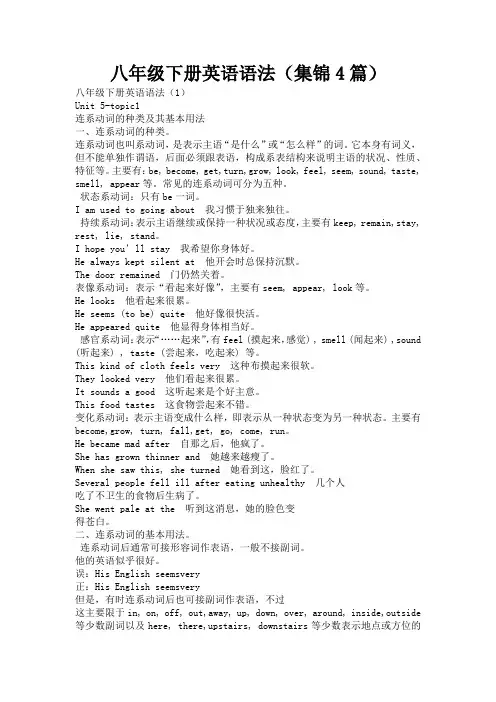
八年级下册英语语法(集锦4篇)八年级下册英语语法(1)Unit 5-topic1连系动词的种类及其基本用法一、连系动词的种类。
连系动词也叫系动词,是表示主语“是什么”或“怎么样”的词。
它本身有词义,但不能单独作谓语,后面必须跟表语,构成系表结构来说明主语的状况、性质、特征等。
主要有:be, become, get,turn,grow, look, feel, seem, sound, taste, smell, appear等。
常见的连系动词可分为五种。
状态系动词:只有be一词。
I am used to going about 我习惯于独来独往。
持续系动词:表示主语继续或保持一种状况或态度,主要有keep, remain,stay, rest, lie, stand。
I hope you’ll stay 我希望你身体好。
He always kept silent at 他开会时总保持沉默。
The door remained 门仍然关着。
表像系动词:表示“看起来好像”,主要有seem, appear, look等。
He looks 他看起来很累。
He seems (to be) quite 他好像很快活。
He appeared quite 他显得身体相当好。
感官系动词:表示“……起来”,有feel (摸起来,感觉) , smell (闻起来) ,sound (听起来) , taste (尝起来,吃起来) 等。
This kind of cloth feels very 这种布摸起来很软。
They looked very 他们看起来很累。
It sounds a good 这听起来是个好主意。
This food tastes 这食物尝起来不错。
变化系动词:表示主语变成什么样,即表示从一种状态变为另一种状态。
主要有become,grow, turn, fall,get, go, come, run。
He became mad after 自那之后,他疯了。
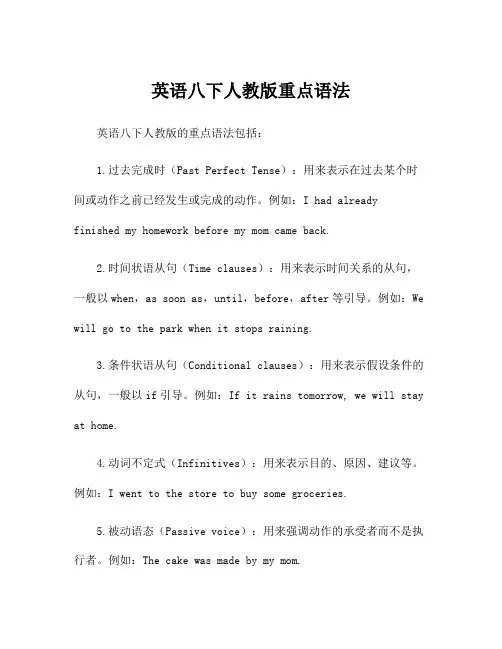
英语八下人教版重点语法
英语八下人教版的重点语法包括:
1.过去完成时(Past Perfect Tense):用来表示在过去某个时间或动作之前已经发生或完成的动作。
例如:I had already
finished my homework before my mom came back.
2.时间状语从句(Time clauses):用来表示时间关系的从句,一般以when,as soon as,until,before,after等引导。
例如:We will go to the park when it stops raining.
3.条件状语从句(Conditional clauses):用来表示假设条件的从句,一般以if引导。
例如:If it rains tomorrow, we will stay at home.
4.动词不定式(Infinitives):用来表示目的、原因、建议等。
例如:I went to the store to buy some groceries.
5.被动语态(Passive voice):用来强调动作的承受者而不是执行者。
例如:The cake was made by my mom.
6.定语从句(Relative clauses):用来修饰名词或代词的从句,一般由关系代词who,which,that引导。
例如:The boy who won
the competition is my neighbor.
这些语法结构在英语八下人教版教材中经常出现,需要学生掌握
和应用。
希望以上回答能对您有帮助。
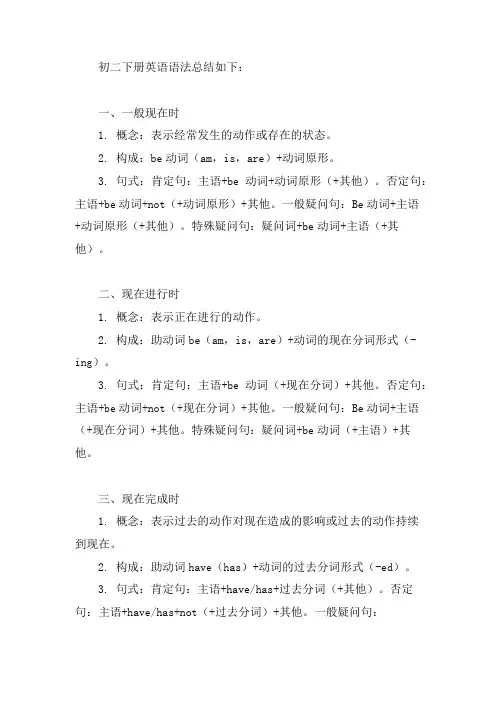
初二下册英语语法总结如下:一、一般现在时1. 概念:表示经常发生的动作或存在的状态。
2. 构成:be动词(am,is,are)+动词原形。
3. 句式:肯定句:主语+be动词+动词原形(+其他)。
否定句:主语+be动词+not(+动词原形)+其他。
一般疑问句:Be动词+主语+动词原形(+其他)。
特殊疑问句:疑问词+be动词+主语(+其他)。
二、现在进行时1. 概念:表示正在进行的动作。
2. 构成:助动词be(am,is,are)+动词的现在分词形式(-ing)。
3. 句式:肯定句:主语+be动词(+现在分词)+其他。
否定句:主语+be动词+not(+现在分词)+其他。
一般疑问句:Be动词+主语(+现在分词)+其他。
特殊疑问句:疑问词+be动词(+主语)+其他。
三、现在完成时1. 概念:表示过去的动作对现在造成的影响或过去的动作持续到现在。
2. 构成:助动词have(has)+动词的过去分词形式(-ed)。
3. 句式:肯定句:主语+have/has+过去分词(+其他)。
否定句:主语+have/has+not(+过去分词)+其他。
一般疑问句:Have/has+主语(+过去分词)+其他。
特殊疑问句:疑问词+have/has+主语(+过去分词)+其他。
四、一般将来时1. 概念:表示将要发生的动作或存在的状态。
2. 构成:助动词will+动词原形。
或用be going to do形式表示将来打算做某事。
3. 句式:肯定句:主语+will(+动词原形)+其他。
否定句:主语+will+not(+动词原形)+其他。
一般疑问句:Will+主语(+动词原形)+其他。
特殊疑问句:疑问词+will(+主语)+其他。
或疑问词+be going to do+其他。
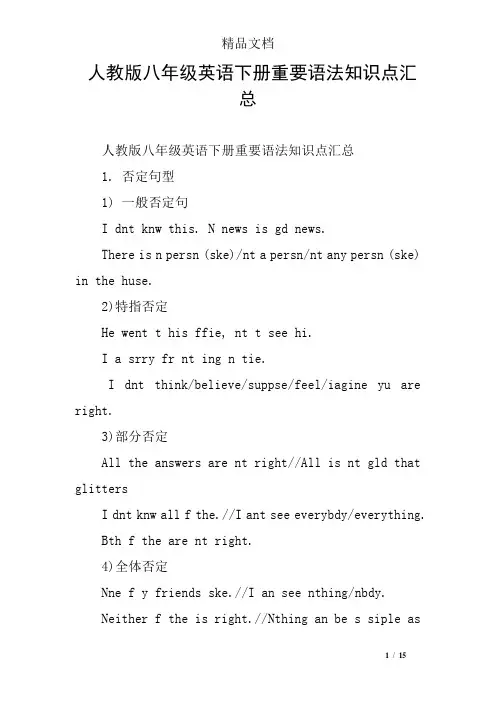
人教版八年级英语下册重要语法知识点汇总人教版八年级英语下册重要语法知识点汇总1. 否定句型1) 一般否定句I dnt knw this. N news is gd news.There is n persn (ske)/nt a persn/nt any persn (ske) in the huse.2)特指否定He went t his ffie, nt t see hi.I a srry fr nt ing n tie.I dnt think/believe/suppse/feel/iagine yu are right.3)部分否定All the answers are nt right//All is nt gld that glittersI dnt knw all f the.//I ant see everybdy/everything.Bth f the are nt right.4)全体否定Nne f y friends ske.//I an see nthing/nbdy.Neither f the is right.//Nthing an be s siple asthis.5) 延续否定yu didnt see hi, neither/nr did I.yu dnt knw, I dnt knw either.He desnt knw English, let alne/t say nthing f/nt t speak f (更不用说) Frenh.6) 半否定句e seld/hardly/sarely/barely hear suh fine singing.I knw little English. I saw few peple.7) 双重否定yu ant ake sething ut f nthing.//hats dne annt be undne.There is n sweet withut sweat.//N gain withut pains.I ant help /keep/ laughing whenever I hear it.N an is s ld but (that) he an learn.8)排除否定Everyne is ready exept yu.//He did nthing but play.But fr yur help, I uldnt d it.9)加强否定I wnt d it at all.//I ant see it any re.//He is n lnger a by.2. 判断句型1) 一般判断句It is iprtant fr us t learn English.It is kind f yu t help e sinere eans hnest.The by is alled/naed T.e regarded/nsider it as an hnr.2)强调判断It is English that we shuld learn.//It is he wh helped e a lt.3)弱式判断yur sentene desnt sund/lk/appear/feel right.yu lk/see as if/as thught yu had been there befre.aybe/Perhaps/ she is ill.He is prbably ill.//He is likely ill. //It is pssible that he is late4) 注释判断He an reeber s any English wrds, that is (t say) he is a living ditinary.(活字典)5) 正反判断That sunds all right, but in fat it is nt.6) 比较判断It is re a piture than a pe.7) 互斥判断He r yu are wrng. Either he is right r I a.3. 祝愿祁使句式1) 一般句式Study hard and keep fit. Be brave! Dnt be shy! Get ut f here.2)强语式D tell e. Never tell a lie.3) 委婉祈使句Please tell e the true. uld/ill/nt d e a favr?uld/D yu ind y sking? hat/Hw/ abut ging n ft?4)建议祈使句Let us g. Let us knw the tie. Dnt let the fire ut.Lets nt waste the tie. yud better start early.Shall we listen t se usi? hy dnt yu get sething t drink?Suppse/suppsing yu pik e up at abut six?I suggest we (shuld) take the train.5)祝愿句Suess t yu! //ish yu a gd urney.ay yu have a happy arriage. //Heres t yur suess!Allw e t prpse a tast t ur friendship!4. 感叹句型Hw well he speaks! //Hw kind she is! //hat a nie weather it is!Here he es! //Suh is life! //nderful! // Help!5. 疑问句型1) 一般疑问句Is he a dtr?//D yu the way t the statin?2)反意疑问句He is a teaher, isnt he?//It is quite heap, dnt yu think?3) 特殊疑问句hat is the distane/width/size/ppulatin/teperature/fare?h is he? hat is he?(干什么的)//hat is he like? // Hw is he?Hw d yu like hi? //hat d yu think f hi?hat ever d yu ean by saying this?4)选择疑问句He is a dtr r a nurse?5)间接疑问句D yu knw hw ld he is? //Tell e if (whether) yu like it.hat d yu think/say/suppse I shuld d?6. 数词句型1) 表数目It is exatly ten lk.//It is five iles away fr here.He is re than/ver/ at least nt less than 20.He is under/at st/n re than 20.2)表年月日He was brn n April 22 1994/in 1994 n the rning f t.1.3)表年龄He is 20 years ld/years f age.//He is at the agef 10.4)表倍数It is fur ties that f last years.This is fur ties as big (again) as that ne.This is fur ties bigger than that ne.The ine is duble what it was.The utput f al was 200% greater than in 1998.5)表计量It is 10 eters lng/wide/high.//It sts e 100 yuan.I spent 10 hurs t finish it.//It tk e 10 days t finish it.It is wrth 100 yuan.7. 关联指代句型1)两项关连I have tw bks, ne is hinese; the ther English.I have five bks, ne is hinese; the thers English.T say is ne thing, but/and/ t d is anther.ne the ne hand, I a yur teaher, and n the ther hand, I a als yu friend.Se like t play ftball, thers are fnd f basketball.2)先后顺序First/firstly, I wish gd health, send/sendly suess in yur study, third/thirdly gd luk in everything.First stp, then lk, finally rss.At first/in the beginning/ he wrd hard. Later/Afterwards he is nt s diligent.3)修饰限制This is the sae bk as I lst yesterday.This is the sae bk that I lst yesterday.(同一本书)Dnt trust suh a an as ver praise yu.He/ne/Thse/They wh shuld e failed t appear.A an/A persn/The ne/Anyne/Peple wh saw her liked her very uh.The day/tie/ent will e when hina is strngest in the wrld.4) 两项连接He an speak nt nly English but als Frenh.The bk is bth interesting and instrutive.It is neither ld nr ht.Please either e in r g ut.The ld wrker has experiene and knwledge as well.5)加和关系Besides literature, we have graar and writing.Apart fr xygen, there are se ther gases in the air.In additin t "if", there is any ther nuntins that an intrdue nditinal lauses.I ust g nw, inidentally, if yu want that bk.yu see t like tea, s d I.8. 比较句型1)等比句He is as tall as I. // He is the sae height as I.She is n less diligent than he. The lab is n better than a ttage.2) 差比句I speak English wrse than he des.//He is nt s/astall as I a.ur knwledge is uh inferir t their.3) 极比句He is the tallest f all in the lass.Nne/N ne/ is s blind as thse that wnt see.Nthing is s easy as this.4)比例句The re a an knws, the re he feels his ignrane(无知).5) 择比句He is taller than any ther by in the lassIt is better late than never.//They wuld die than live as slavesHe prefers ding t talking//He prefers t d rather than t talk.He prefers atheatis t English.//Id rather stay here.6)对比句yu think e idle, but n the ntrary, I a busy.They are wrking hard while yu are wasting yur tie.9. 比喻句型e ust wrk like hi.//He behaves as his father des.He speaks English as if/thugh he was a freigner.10. 条件假设句1) 一般事实If we sueed, what will the peple say?Suppse it rains, what shall we d?Persevere(坚持) and yull sueed.2)虚拟条件句If I were yu, I wuld g.//If yu had seen it, yu wuld have been ved.3)反条件句Unless yu try, yull never sueed.//Dnt ve, r/else/therwise Ill sht.4)唯一条件句If nly I have anther hane, I shall d better.nly in this way an we learn English well.S/As lng as we dnt lse heart, well sueed.5)推论条件句Sine that is s, there is n re t say.Nw that yu are grwn up, yu ust stp this behavir.11. 时间句型1)一般时hen I see hi, Ill tell hi.2) 表同时yull grw wiser as yu grw lder.rk while yu wrk, play while yu play.He wrked, at the sae/in the eantie he listened t the usi.3)限制时Every/eah tie when I went t his huse, he was ut.By the tie that we gt there, he was ut.4)交替时Seties he sings, seties he danes.At ne tie the baby ries, at anther it talks.5)先时I stpped he befre he began t talk with e.6)后时Ill tell yu after I finish it.7)紧接时As sn as I see hi, Ill tell hi.ne yu begin, yu ust ntinue.The (very) ent/instant (that) I saw hi, I regnized hi.n hearing the news, she bust int tears.Hardly had I seen the light, when I heard a lud thundering.8)延续时I havent seen hi sine I ae here.A friend is never knw till/until a an have need.12. 地点句型1) 一般地点here have yu been?here there is a will, there is a way.2)方位Hebei lies in the east f hina.apan is lies t the east f hina.The huse faes (t) the suth.He is sitting at the frnt f the lassrHe is standing in frnt f/befre e.He is sitting at the bak f/behind e.He is sitting in the bak f/at the rear f the lassr. He is sitting next t/besides e.He is sitting lse t/near e.At the tp f/n tp f the shelf, there are se bks. He is sitting n the left/right.The untain yu see t the right is the Purple untain.13. 原因句型He didnt g t shl beause he was ill.Sine we are all here, lets begin ur eeting.It ight rain yesterday, fr the grund was wet.Nw (that) we have finished the wrk, we an g he.I a glad t eet yu.I a srry that I hear that.Thank yu fr yur help.That is why he failed t e.He didnt e beause f/n aunt f the weather.He went ut f urisity.I sueeded thanks t his help.This failure is due t the fat they lak experiene.wing t ur int effrts, the task was fulfilled.hat are studying English fr?Fr what reasn did yu hse this?hats the pint f asking his t d that?Hw e yu never tld e abut it?hat with the wind and what with the rain, ur walk was spiled.14. 目的句型He stpped aside s that she uld g in.He sits in the frnt in rder that he an see wrds learly.He gets up early s as t/in rder t have tie t d exerises.He repeated it fr fear that there shuld be any istake.15. 结果句型It was very ld, s that the river frze.They st a lt f ney, s/therefre we use the arefully.He is suh a gd an that every ne likes hi.He ran s fast that n ne uld ath hi.He hurried t the huse nly t find that it was epty.I was aught in the rain. As a result, I had a bad ld.16. 程度句型Hw ften d yu write t yur parents?Hw lng d yu stay at he?It is s beautiful that we all lve it.It is t big fr yu.He is t exited t speak.He is nt ld enugh t knw this.The letter ust be sent as sn as pssibleyu ust wrk as hard as yu an.As far as I knw, I an speak nly English.17. 让步句型Thugh/Althugh he is rih, (yet/still) he desnt shw ff.yang as he is, he knw a lt f things.Even if/thugh he sueeded, he was nt prud.N atter what yu say, Ill still try t d it.keep al, whatever happens.In spite f this, we ust g ahead with ur plans.Regardless f all the diffiulties, well fight it ut t the end.18. 转折句型I searhed everywhere but uld nt find hi.yu ay g, nly return quikly.He is seriusly ill, still there is hpe f his revery.It lked like rain, hwever it was lear in the afternn.He is still yung, yet he is high up in the psitin.He didnt tell e the truth, I knw it, thugh.19. 省略句I think/say/suppse/expet/believe/hpe s.hy nt e earlier next tie?。
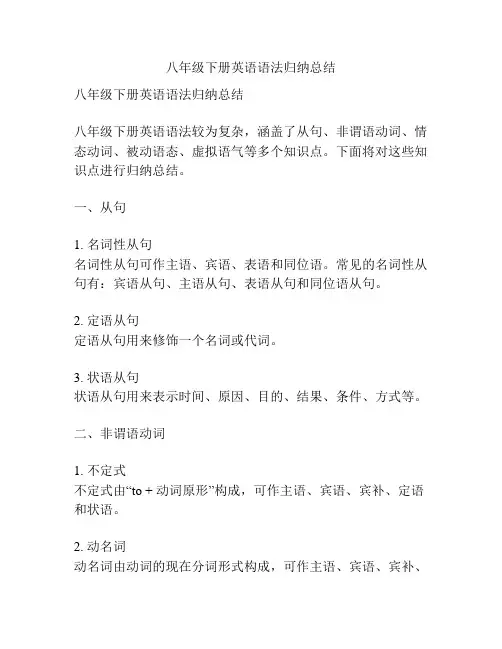
八年级下册英语语法归纳总结八年级下册英语语法归纳总结八年级下册英语语法较为复杂,涵盖了从句、非谓语动词、情态动词、被动语态、虚拟语气等多个知识点。
下面将对这些知识点进行归纳总结。
一、从句1. 名词性从句名词性从句可作主语、宾语、表语和同位语。
常见的名词性从句有:宾语从句、主语从句、表语从句和同位语从句。
2. 定语从句定语从句用来修饰一个名词或代词。
3. 状语从句状语从句用来表示时间、原因、目的、结果、条件、方式等。
二、非谓语动词1. 不定式不定式由“to + 动词原形”构成,可作主语、宾语、宾补、定语和状语。
2. 动名词动名词由动词的现在分词形式构成,可作主语、宾语、宾补、定语和状语。
3. 分词分词分为现在分词和过去分词。
现在分词以-ing结尾,常作定语和状语。
过去分词有规则变化和不规则变化,常作定语和宾补。
三、情态动词常见的情态动词有can、could、may、might、must、shall、should、will、would等。
情态动词用法灵活,表示能力、允许、推测、义务、愿望、建议等。
四、被动语态被动语态由“be + 过去分词”构成,表示主语是动作的承受者。
被动语态可用于各种时态和情态动词,还可以用在不定式、动名词和从句中。
五、虚拟语气虚拟语气用来表示与事实相反的假设、愿望、建议等。
常见的形式有虚拟条件句、虚拟语气与情态动词和虚拟语气用法。
以上是八年级下册英语语法的归纳总结,对于这些知识点,需要多加练习和深入理解。
通过不断的练习,掌握这些语法知识将对英语的学习和提高有很大的帮助。
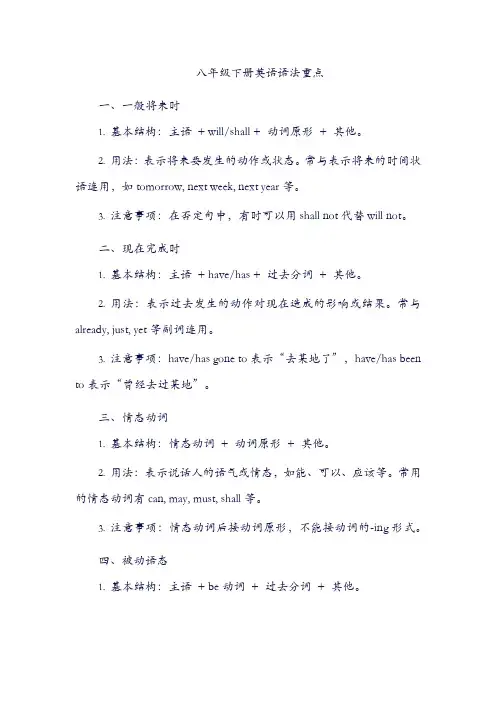
八年级下册英语语法重点一、一般将来时1.基本结构:主语+ will/shall + 动词原形+ 其他。
2.用法:表示将来要发生的动作或状态。
常与表示将来的时间状语连用,如tomorrow, next week, next year等。
3.注意事项:在否定句中,有时可以用shall not代替will not。
二、现在完成时1.基本结构:主语+ have/has + 过去分词+ 其他。
2.用法:表示过去发生的动作对现在造成的影响或结果。
常与already, just, yet等副词连用。
3.注意事项:have/has gone to表示“去某地了”,have/has been to表示“曾经去过某地”。
三、情态动词1.基本结构:情态动词+ 动词原形+ 其他。
2.用法:表示说话人的语气或情态,如能、可以、应该等。
常用的情态动词有can, may, must, shall等。
3.注意事项:情态动词后接动词原形,不能接动词的-ing形式。
四、被动语态1.基本结构:主语+ be动词+ 过去分词+ 其他。
2.用法:表示主语是动作的接受者。
常与by引导的方式状语连用,如by machine, by air等。
3.注意事项:被动语态的时态变化主要通过be动词的变化来实现,不同时态的被动语态需要注意与该时态的主动语态相对应。
五、不定代词和冠词用法1.不定代词:表示泛指或不确定的代词,如some, any, other等。
some用于肯定句,any用于否定句或疑问句;other表示“其他的”。
2.冠词:表示特指或泛指的词,分为定冠词the和不定冠词a/an。
a用于辅音音素开头的单词前,an用于元音音素开头的单词前;the 表示特指或上文提到的某个名词。
3.用法:不定代词和冠词一起使用时,可以构成限定词短语,如some books, the school gate等。
限定词短语可以修饰名词,表示特指或泛指的概念。
4.注意事项:在英语中,不定代词和冠词的使用是有规则和限制的,需要根据上下文和语境来判断使用哪个代词或冠词。
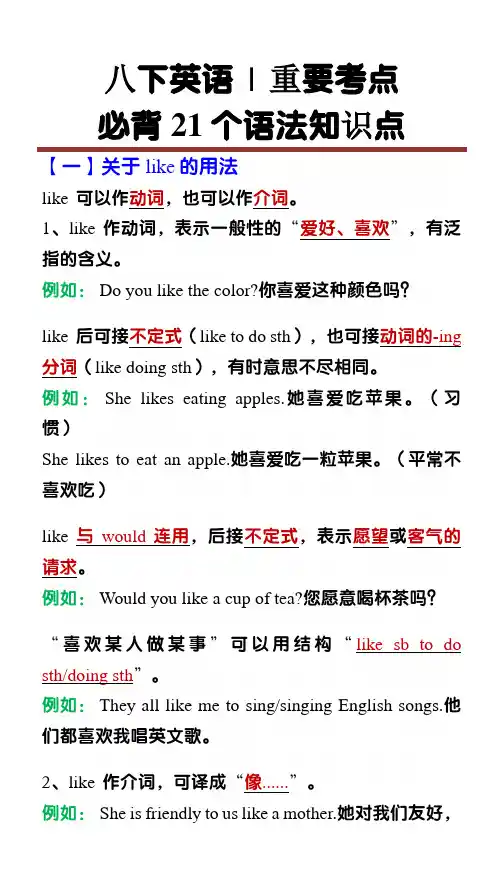
八下英语| 重要考点必背21个语法知识点【一】关于like的用法like 可以作动词,也可以作介词。
1、like 作动词,表示一般性的“爱好、喜欢”,有泛指的含义。
例如: Do you like the color?你喜爱这种颜色吗?like 后可接不定式(like to do sth),也可接动词的-ing 分词(like doing sth),有时意思不尽相同。
例如: She likes eating apples.她喜爱吃苹果。
(习惯)She likes to eat an apple.她喜爱吃一粒苹果。
(平常不喜欢吃)like 与would 连用,后接不定式,表示愿望或客气的请求。
例如: Would you like a cup of tea?您愿意喝杯茶吗?“喜欢某人做某事”可以用结构“like sb to do sth/doing sth”。
例如: They all like me to sing/singing English songs.他们都喜欢我唱英文歌。
2、like 作介词,可译成“像......”。
例如: She is friendly to us like a mother.她对我们友好,就像母亲一样。
It looks like an orange.它看起来像个桔子。
【二】不定冠词a与an的使用1.a 用在以辅音音素开头的单词前。
例如:There is a "b" in the word "book".单词book中有个字母b。
类似的字母还有:c, d, g, j, k, p, q, t, u, v, w, y, z。
She has a small knife.她有一把小刀。
2.an 用于以元音音素开头的单词前。
例如: There is an "i" in the word "onion".单词onion中有个字母i。
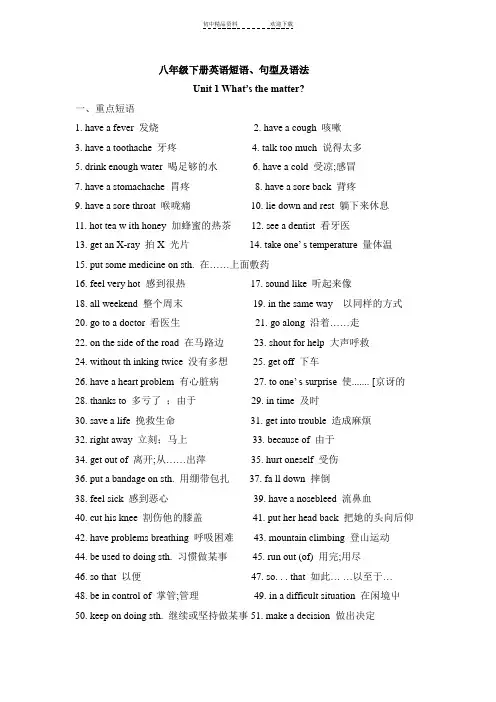
八年级下册英语短语、句型及语法Unit 1 What’s the matter?一、重点短语1. have a fever 发烧2. have a cough 咳嗽3. have a toothache 牙疼4. talk too much 说得太多5. drink enough water 喝足够的水6. have a cold 受凉;感冒7. have a stomachache 胃疼8. have a sore back 背疼9. have a sore throat 喉咙痛10. lie down and rest 躺下来休息11. hot tea w ith honey 加蜂蜜的热茶12. see a dentist 看牙医13. get an X-ray 拍X 光片14. take one’ s temperature 量体温15. put some medicine on sth. 在……上面敷药16. feel very hot 感到很热17. sound like 听起来像18. all weekend 整个周末19. in the same way 以同样的方式20. go to a doctor 看医生21. go along 沿着……走22. on the side of the road 在马路边23. shout for help 大声呼救24. without th inking twice 没有多想25. get off 下车26. have a heart problem 有心脏病27. to one’ s surprise 使....... [京讶的28. thanks to 多亏了;由于29. in time 及时30. save a life 挽救生命31. get into trouble 造成麻烦32. right away 立刻;马上33. because of 由于34. get out of 离开;从……出萍35. hurt oneself 受伤36. put a bandage on sth. 用绷带包扎37. fa ll down 摔倒38. feel sick 感到恶心39. have a nosebleed 流鼻血40. cut his knee 割伤他的膝盖41. put her head back 把她的头向后仰42. have problems breathing 呼吸困难43. mountain climbing 登山运动44. be used to doing sth. 习惯做某事45. run out (of) 用完;用尽46. so that 以便47. so. . . that 如此… …以至于…48. be in control of 掌管;管理49. in a difficult situation 在闲境屮50. keep on doing sth. 继续或坚持做某事51. make a decision 做出决定52. take risks 冒险53. give up 放弃二、重点句型1. Wha t’ s the matter?Wha t’ s the matter with you?= What’s the trouble w ith you?= Wha t’ s wrong with you? 你怎么了?2. What should she do?她该怎么办呢?Should I take my temperature?我应该量一下体温吗?主语+ should/shouldn’t + 动词原形. ..①You should lie down and rest.你应该躺下休息一会儿。
英语八年级下册第二单元语法知识1、表示经常性或习惯性的动作,常与表示频率的时间状语连用,表示现在的动作或状态,如:always, usually, often, sometimes, rarely, never, every day(week, month, year)等。
2、表示状态的动词常常用一般现在时,如:think, know, believe, understand, remember, forget, want, wish, expect, suppose, need, have 等。
3、表示客观事实的动词常用一般现在时,如:rain, snow, blow, grow, exist, need, cost, belong, live 等。
4、主语是第三人称单数时,谓语动词用一般现在时。
5、一般现在时的句子结构:主语(第三人称单数)+动词(一般现在时)+其他。
二、一般过去时:1、表示过去发生的动作或状态,如:yesterday, last night(year, week, month, summer), ago等。
2、过去发生的动作或状态,用一般过去时表示,如:say, think, do, believe, know, forget, want, remember, understand, expect, wish, suppose, have 等。
3、一般过去时的句子结构:主语(第三人称单数)+动词(一般过去时)+其他。
三、现在进行时:1、表示当前正在进行或发生的动作,如:now, at present, at the moment, still, look 等。
2、表示经常性的动作或一段持续的动作时,常用现在进行时,如:work, play, read, run, swim, stay 等。
3、现在进行时的句子结构:主语(第三人称单数)+ be 动词(am, is, are)+ 动词(现在分词)+ 其他。
初二英语下册语法现在进行时的基本用法1.表示说话时正在进行的动作常和now 连用,有时用一个look、listen ,来表now 这一时间概念。
*Look! A train is coming .看,火车来了。
*Listen! He is playing the piano.听,他在弹琴。
2.表示现阶段正在进行的动作但不一定是说话时正在进行。
常和at present ,this week ,these days…等时间状语连用。
*What lesson are you studying this week?你们本周学哪一课了?(说话时并不在学)3.现在进行时有时可用来表示一个在最近按计划或安排要进行的动作即是说可以用来代替将来时,但此时,一般要与表示将来时的时间状语连用,而且仅限于少量动词。
如:go, come, leave, start, arrive, return . sleep*Are you going to Tianjin tomorrow? 你明天去天津吗?*How many of you are coming to the party next week? 你们有多少人下周要来参加晚会?一般将来时1.be going to+ 动词原形~对于将要发生的事,或打算、计划、决定要做的事情时,皆以be going to + 动词原形的句型来表示。
因此此句型有be动词,所以是否用am, is, are ,决定于主语。
肯定句:主语+be (is, am, are) going to +动词原形I am going to play football next Sunday. 下周日我打算踢足球。
They are going to meet outside the school gate. 他们打算在校门口见面。
It is going to rain. 要下雨了。
否定句:主语+be (am, are, is) not going to +动词原形We are not going to have any classes next week. 下周我们不上课。
一、情态动词的用法情态动词+动词原形:表示对现在或将来的情况作推测。
情态动词+动词现在进行时:表示对现在正在发生的事情进行推测。
情态动词+动词完成时:表示对过去的情况进行推测。
情态动词+动词完成进行时:表示对过去正在发生事情的推测。
情态动词+动词不定式完成式:表示“本应当做某事而没做”。
情态动词的否定式:一般在后面加not。
二、形容词和副词的比较级和最高级的构成原级用“as…as”或“not as(so)…as”结构表示比较。
比较级用“than”结构表示比较。
最高级用“the+最高级+名词+表示范围的短语或从句”结构表示。
三、动词时态一般现在时:表示经常发生的动作或存在的状态,常与always,often,seldom,every day 等连用。
现在进行时:表示正在进行的动作,常与now连用。
过去进行时:表示过去某一时间正在进行的动作,常与at that time连用。
一般将来时:表示将来要发生的动作或存在的状态,常与tomorrow,next week等连用。
可以表示为“will/shall+动词原形”结构。
过去将来时:表示从过去某一时间看将要发生的动作或存在的状态,常与the next day,tomorrow等连用。
可以表示为“would/should+动词原形”结构。
现在完成时:表示过去发生的动作对现在造成的影响或结果,常与just now,already,yet 等连用。
结构为“have/has+动词的过去分词”。
过去完成时:表示过去某一时间或动作之前已经完成的动作或存在的状态,即“过去的过去”。
结构为“had+动词的过去分词”。
四、名词性从句和定语从句的用法名词性从句包括主语从句、宾语从句、表语从句和同位语从句。
引导这些从句的词有连词that、whether、if以及连接代词who、whom、whose、what、which和连接副词when、where、how、why等。
其中,that在句中无词义,只起连接作用;if、whether有词义,当“是否”“是不是”讲。
八年级下册英语语法知识点_英语语法知识点汇总八年级下册英语语法知识点_英语语法知识点汇总据最新了解,八年级下册英语语法知识点有哪些大家知道吗?为了方便大家学习借鉴,下面小编精心准备了八年级下册英语语法知识点内容,欢迎使用学习!八年级下册英语语法知识点Module 1一.固定词组1.a bit2.be done3.have a try4.in the middle5.hear from6.each other7.as well8.be proud of9.be good at 10a few 11.in the right way12.be excited about 13.help sb. with sth.14.shake hands with 15.talk with二.用法点拨1.would like + to do sth. 想做某件事 = want to do sth.2.I’m afraid ... 恐怕...3.Shall I ...? 我...吧?4.be sure + 句子确信... 主语是sb.5.Thanks for doing sth. 因做某事而感谢 = Thank you for doing sth.6.It + be +形容词 + to do sth. 做某事很...7.can’t to do sth. 迫不及待做某事8.how to do sth. 如何做某事9.be afraid of doing sth. 害怕做某事10.ask sb. (not) to do sth. 要求某人(不要)做某事11.much + 比较级 ...得多三.语法专项表示感觉,感官和知觉的连系动词:feel、look、smell、sound、taste__这些连系动词,后面通常接形容词Module 2一.固定词组1.lots of2.enter a competition3.first prize4.good luck5.think about6.a lot = very7.make up8.at the moment9.for example 10.be different from 11.so far 12.count down 13.by train14.have a wonderful time 15.find out二.用法点拨1.help sb. + do sth. 帮助某人做某事2.stop doing sth.停止做某事3.need(实意动词) + to do sth.4.Invite sb. + to do sth. 邀请某人做某事5.one of + the +形容词最高级+复数名词表示“最...之一”6.love doing sth. 喜爱做某事7.have been to + sw. 去过某地(但已经回来) have gone to + sw. 去了某地(现在没回来)8.begin to do sth. 开始做某事9.enjoy doing sth. 喜欢做某事10.learn to do sth. 学习做某事三.语法专项现在完成时:构成have/has + 动词过去分词__不规则动词需额外记忆。
以下是八年级下册英语的一些重要语法知识:
1. 现在完成时:表示过去发生的动作对现在造成的结果。
基本结构是“have/has + 过去分词”。
2. 过去进行时:表示在过去某一时刻或时间段内正在发
生的动作。
基本结构是“was/were + 动词的现在分词”。
3. 情态动词:表示说话人对某一动作的看法或态度。
常
用的情态动词有can、may、must、should等。
4. 动词不定式:表示某一动作的目的或计划。
基本结构
是“to + 动词原形”。
5. 被动语态:表示主语是动作的接受者。
基本结构是
“be + 动词的过去分词”。
6. 形容词的比较级和最高级:表示两个或多个事物之间
的相对大小或程度。
形容词的比较级和最高级有规则和不规
则两种形式。
7. 连词:连接两个或多个句子或子句,表示它们之间的
关系。
常用的连词有and、but、or、so等。
8. 介词:表示名词、代词等与句子其他成分之间的关系。
常用的介词有in、on、at、by等。
9. 祈使句:表示请求、命令或建议等。
基本结构是“动
词原形 + 感叹号”。
10. 条件状语从句:表示假设条件或未来的可能性。
基本
结构是“if + 从句主语 + 动词的一般现在时 + 主句”。
以上是八年级下册英语的一些重要语法知识,需要在学习
过程中重点掌握和运用。
八年级下册英语复合句语法知识点归纳总结复合句是由两个或更多的句子组成的句子。
下面是八年级下册英语复合句的一些常见语法知识点总结:1. 关系代词关系代词用来引导定语从句,常见的关系代词有:who, whom, whose, which, that。
关系代词在从句中作为主语、宾语、或定语。
例句:- The girl who is wearing a red dress is my sister.- This is the book that I borrowed from the library.2. 定语从句定语从句用来修饰名词或代词,给出更多的信息。
定语从句通常用关系代词引导。
例句:- The house where he was born is now a museum.3. 时间状语从句时间状语从句用来表示时间,通常由when, while, before, after, since, until等引导。
例句:- I will visit my grandparents when I have time.4. 原因状语从句原因状语从句用来表示原因,通常由because, since, as等引导。
例句:5. 结果状语从句结果状语从句用来表示结果,通常由so, such...that, so that等引导。
例句:- The weather was so cold that we couldn't go outside.6. 目的状语从句目的状语从句用来表示目的,通常由in order to, so as to等引导。
例句:- I study hard in order to pass the exam.7. 条件状语从句条件状语从句用来表示条件,通常由if, unless, as long as, provided that等引导。
例句:- If it rains, we will stay indoors.以上是八年级下册英语复合句的一些常见语法知识点。
初二英语下册语法现在进行时的基本用法1.表示说话时正在进行的动作常和now 连用,有时用一个look、listen ,来表now 这一时间概念。
*Look! A train is coming .看,火车来了。
*Listen! He is playing the piano.听,他在弹琴。
2.表示现阶段正在进行的动作但不一定是说话时正在进行。
常和at present ,this week ,these days…等时间状语连用。
*What lesson are you studying this week?你们本周学哪一课了?(说话时并不在学)3.现在进行时有时可用来表示一个在最近按计划或安排要进行的动作即是说可以用来代替将来时,但此时,一般要与表示将来时的时间状语连用,而且仅限于少量动词。
如:go, come, leave, start, arrive, return . sleep*Are you going to Tianjin tomorrow? 你明天去天津吗?*How many of you are coming to the party next week? 你们有多少人下周要来参加晚会?一般将来时1.be going to+ 动词原形~对于将要发生的事,或打算、计划、决定要做的事情时,皆以be going to + 动词原形的句型来表示。
因此此句型有be动词,所以是否用am, is, are ,决定于主语。
肯定句:主语+be (is, am, are) going to +动词原形I am going to play football next Sunday. 下周日我打算踢足球。
They are going to meet outside the school gate. 他们打算在校门口见面。
It is going to rain. 要下雨了。
否定句:主语+be (am, are, is) not going to +动词原形We are not going to have any classes next week. 下周我们不上课。
I’m not going to be a teacher.我不打算当老师。
He isn’t going to see his brother tomorrow.他明天不准备去看他哥哥。
疑问句:Be (Am, Is, Are) +主语+ going to + 动词原形Are you going to be a doctor when you grow up? 你长大了,打算当一名医生吗?will 同be going to 的用法相同以今天为起点的所有将来时间,如:this afternoon / this evening = tonight / tomorrow/ tomorrow morning / afternoon / evening ,the day after tomorrow / next week ,next Wednesday / next month,next September / next year.★ “be going to + 动词原形” 表示计划、打算、将来发生的动作,常和this afternoon (今天下午),this evening = tonight (今晚),tomorrow (明天),tomorrow morning (afternoon , evening ) (明早,午,晚),the day after tomorrow(后天),next Sunday (下个星期天), next week (下周), next month (下个月), next year (明年)等的时间状语连用,前不加任何介词。
另外,动作性动词go ,come 和leave 等的现在进行时表示一般将来时动作。
形容词和副词的比较级和最高级1.比较级:句子表示两者之间的比较时用比较级,其标志词是than, much, a little , even和still等。
e.g. ① Her hair is muc h longer than mine. 她的头发比我的长多了。
② I’m a little older than you.我比你大一点儿。
2.最高级:句子表示三者或多者的比较时用最高级,其标志词是表示范围的in…或of …介词短语。
在句子中,形容词最高级前必须加the。
e.g. ① The boy is the tallest in our class. 这个男孩是我们班最高的。
② Which is the biggest, t he sun, the moon or the earth? ★形容词的比较级和最高级:形容词有三种等级:原级、比较级、最高级。
3.原级:句中只有一者时用原级,其标志词是very, so, too, quite 等。
e.g. His handwriting is very good.他的书法很好。
(一个人不作比较。
)★ 形容词比较级和最高级的构成:1.一般在原级后加er 构成比较级,加est构成最高级。
e.g. small smaller smallestyoung younger youngest2.以不发音的字母e 结尾的形容词,直接加r 或st 构成比较级和最高级。
e.g. nice nicer nicestlate later latest3.以辅音字母+y 结尾的形容词,变y为i ,再加er 或est, 构成比较级和最高级。
e.g. busy busier busiestheavy heavier heaviest4.在重读闭音节中,末尾只有一个辅音字母的形容词,要先双写这个辅音字母,再加er或est,构成比较级和最高级。
e.g. hot hotter hottestbig bigger biggest5.个别形容词的比较级和最高级是不规则变化,需个别记忆。
e.g. good (well) better bestbad (badly, ill) worse worstmany (much) more mostlittle less leastfar farther farthest或 further furthest★ 副词的比较级和最高级:1.以ly 结尾的副词,除early 变为 earlier 和 earliest 外,其余一律在其前加more 和most。
如:carefully – more carefully – most carefully2.规则变化直接加er 和 est 。
如:fast – faster—fastest3.个别词是不规则变化,需要特别记忆。
4.句子中,副词最高级前的the 可省略也可以不省略,但形容词最高级前面的the 绝对不能去掉。
e.g. Who runs (the) fastest, Tom, Jim or Mike?提建议的表达方法、表示需要、询问方向、指点方向★表示建议的基本句型1. Shall I / we + 动词原形?2. Why don’t you + 动词原形 = Why not + 动词原形3. Let’s + 动词原形4. What/ How about + doing sth.★表示需要的基本句型1.表示需要用need。
它可当情态动词和行为动词用。
e.g. ① We need your help.(行为动词)我们需要你的帮助。
② They need finish reading the book today. (情态动词)他们需要今天看完这本书。
2.询问方向,主要有以下几种表达方式:⑴ Is there a bus station near here?附近有汽车站吗?⑵ Where is the nearest bus stop / station? 最近的汽车站在哪里?⑶ Which is the way to the bus station ?去汽车站的路是那一条?⑷ How can I go to the bus station? 如何去公共汽车站?3.指点方向,主要有以下几种表达方式:⑴ Go / walk along the road / street. 沿着这条路/街走。
⑵ Take the first (second…) turning on the right / left.在第一(二……)个路口向右/左转。
⑶ It’s next to (in front of , behind…)它在……旁边(前面,后面……)⑷ It’s about a hundred met res along on the left. 它在左前方大约一百米处。
⑸ Turn right / left. = turn to the right / left.向右/左拐。
一般过去时◆一般过去时主要表示过去的动作或状态。
在句子中由主语+动词的过去式来表达。
1.He walks to school. (一般现在时)2.He walked to school. (一般过去时)There is (are ) 的句型用于一般过去时需把is ,are 变为它们的过去式:There was (were) …◆一般动词的过去时一般动词过去式的基本句型如下:◈He played tennis last week. (肯定句) 他上周打网球了。
◈He did not play tennis last week. (否定句) 上周他没打网球。
◈Did he play tennis last week? (疑问句) 上周他打网球了吗?◈You didn’t do your best to do it.你没有尽力去做。
◆一般过去时的基本用法1.带有确定的过去时间状语时,要用过去时如:yesterday (昨天) , two days ago(两天前), last year(去年)., the other day(前几天), once upon a time(过去曾经) , just now(刚才), in the old days(过去的日子里), before liberation(解放前), when I was 8 years old(当我八岁时).2.表示过去连续发生的动作时,要用过去时这种情况下,往往没有表示过去的时间状语,而通过上下文来表示。
◈The boy opened his eyes for a moment, looked at the captain , and died.那男孩把眼睛张开了一会儿,看看船长,然后就去世了。